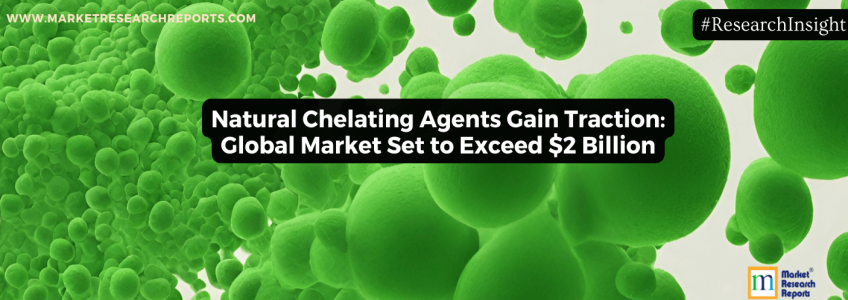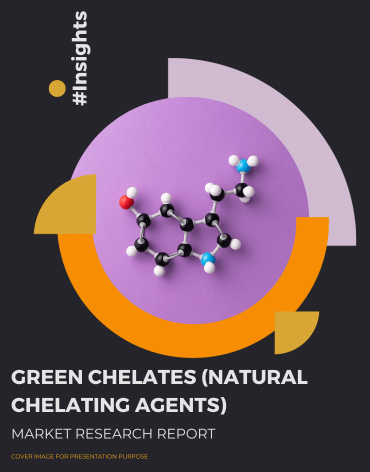Natural Chelating Agents Gain Traction: Global Market Set to Exceed $2 Billion

Chelating agents are compounds that can form coordination complexes with metal ions by donating electron pairs to the metal atom. These complexes are called chelates, and they are often used in various applications, including medicine, industry, and environmental remediation. Chelating agents can be synthetic or natural compounds. Here are some examples of natural chelating agents:
Ethylenediaminetetraacetic Acid (EDTA): EDTA is a synthetic chelating agent commonly used in various applications, but it can also be found in small amounts in some plants. It forms stable complexes with a wide range of metal ions.
Citric Acid: Citric acid is a natural chelating agent found in citrus fruits such as lemons and oranges. It can form complexes with metal ions and is often used as a food preservative and in cleaning products.
Phytic Acid (Inositol Hexaphosphate): Phytic acid is a naturally occurring compound found in seeds, grains, and legumes. It is a potent chelating agent for various metal ions and is often considered an anti-nutrient because it can reduce the bioavailability of certain minerals in the digestive system.
Tannins: Tannins are polyphenolic compounds found in various plant sources, including tea, wine, and many fruits. They can be complex with metal ions and are responsible for the astringent taste in certain foods and beverages.
Siderophores: These are natural chelating agents produced by microorganisms, such as bacteria and fungi, to acquire iron from their environment. Siderophores have a high affinity for iron and are involved in transporting this essential metal in biological systems.
Hemoglobin: Hemoglobin is a natural chelating agent found in red blood cells. It chelates iron ions, allowing for their transport in the bloodstream to various tissues and organs.
Fulvic Acid: Fulvic acid is a natural organic acid found in soil, compost, and organic matter. It can chelate various minerals, making them more available for plant uptake in agriculture.
Saponins: Saponins are natural compounds found in many plants, including beans, legumes, and some herbs. They can form complexes with various metal ions and are used in traditional medicine and various industrial processes.
Amino Acids: Certain amino acids, such as histidine, cysteine, and methionine, can act as chelating agents. They have functional groups that can bind to metal ions.
1 . Global Market for Green Chelates
The global market for Green Chelates (Natural Chelating Agents) was estimated at $1.715 billion in 2022 and is projected to reach a revised size of $2.407 billion by 2029, growing at a compound annual growth rate (CAGR) of 4.29% during the forecast period from 2023 to 2029.
The North American market for Green Chelates (Natural Chelating Agents) was valued at $381.30 million in 2022 and is expected to reach $541.98 million by 2029, at a CAGR of 4.28% during the forecast period spanning 2023 through 2029.
The Asia-Pacific market for Green Chelates (Natural Chelating Agents) had an estimated value of $493.83 million in 2022 and is anticipated to reach $743.19 million by 2029, with a CAGR of 5.04% during the forecast period from 2023 to 2029.
The European market for Green Chelates (Natural Chelating Agents) was valued at $769.21 million in 2022 and is forecasted to reach $1.031 billion by 2029, at a CAGR of 3.92% during the forecast period spanning 2023 through 2029.
2 . Green Chelates Product Segment
Sodium Gluconate (C6H11NaO7):
- Structure: Sodium gluconate is the sodium salt of gluconic acid, a compound derived from glucose.
- Applications: Sodium gluconate is widely used as a chelating agent and a sequestrant. It is commonly employed in detergents, cleaning products, and industrial processes to prevent the precipitation of metal ions. It is also used in the food and pharmaceutical industries as a stabilizer and regulator of acidity.
Sodium Iminodisuccinate (C6H7Na3O8):
- Structure: Sodium iminodisuccinate is a salt of iminodisuccinic acid, which is a synthetic chelating agent.
- Applications: It is used in various industrial applications, especially as a sequestrant for metal ions in detergents and cleaning products. It can also be used to prevent scale formation in water treatment processes.
EDDS (Ethylenediaminedisuccinic Acid):
- Structure: EDDS is a synthetic chelating agent with two carboxylic acid groups and two amino groups.
- Applications: EDDS is known for its biodegradability, making it an environmentally friendly choice. It is used in detergents, cleaning products, and personal care items as a replacement for less environmentally friendly chelating agents like EDTA.
GLDA (Glutamic Acid Diacetic Acid):
- Structure: GLDA is a biodegradable chelating agent derived from amino acids and is considered more environmentally friendly than some synthetic chelating agents.
- Applications: GLDA is used in cleaning products, detergents, and personal care products as a sequestrant for metal ions. It offers an environmentally responsible alternative to certain traditional chelating agents.
MGDA (Methylglycinediacetic Acid):
- Structure: MGDA is a synthetic chelating agent that contains both carboxylic acid and amino groups.
- Applications: MGDA is used as a chelating agent in a variety of applications, including detergents, cleaning products, and water treatment. It is known for its good biodegradability and is considered a more sustainable alternative to some other chelating agents.






